The smarthome, which gezinsman.nl offers is a professional building automation, but for an affordable price. Gezinsman.nl is able to do this by applying techniques, which are also used for developing military systems. These kind of systems need to be 100% reliable and fault-tolerant. The latter means, that unpredictable behaviour may not result into catastrofic system failure. In order to prevent this, these kind of systems are using a distributed architecture, which basically means that the system intelligence is divided over multiple systems. Gezinsman.nl is using the same architecture for it's products. And with the combination of affordable, but reliable hardware (Raspberry, etc.) and opensource software we manage to keep the price low.
You are probably asking yourself: How do they do it?
Read more, we like to explain it to you.
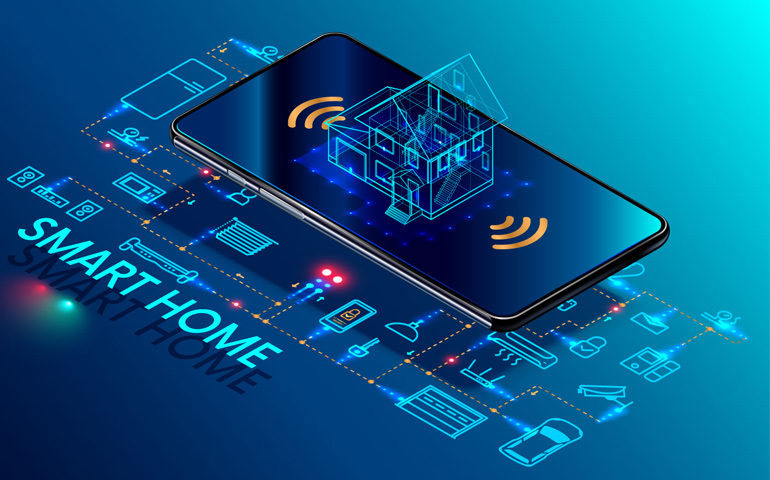
What is a smarthome home?
A lot of people think that equipping the house with smart devices will make the house a smarthome.
Think about the Philips smart lightbulbs, or the Ring smart doorbell.
I can continue for a while, but it all comes in the end to the following:
You can put a monkey behind a PC, the monkey will not get any smarter.
You can let Max Verstappen drive a F1 car, he will not be faster than Hussein Bolt.
And so a home will not get smarter by only equipping it with smart devices. And do these smart devices all operate together?
Probably not. This doesn't make it really appealing and definitely not clear to the users.
Our solution
If you really want to make your house smart, you have to give it a brain, a nervous system, ears, eyes, nose and hands and feet. In short: an infrastructure, which makes it possible for a house to learn tasks en execute them, to grow, to get smarter. And to operate this house you really need one single device.And that is exactly what we do:
- We give the house a brain in the shape of a heavyduty, 24/7, fanless, dual network, Intel Atom x7 Quad-Core SoC, 4GB RAM, 64 GB SSD, micro-PC. This brain has only the dimensions of sigarbox, but is noiseless, energy efficient and will be placed in the meter cupboard next to the gas- and electricity meter. This so-called smartbrain is directly interfaced with these meters through the USB P1-cable. One of the two network connections is connected to the homenetwork, which provide access to the internet.
- The other network connection is connected to a 24/7 heavyduty switch (the backbone), which forms the nervous system of the smarthome.
- This nervous system is directly connected to the sensoric inputs (ears, nose and eyes) and actuator outputs (hands and feet) using smart switches. These smart switches replace the classic light switches and are small enough to be placed in a wallsocket.
What does the practice look like?
May I introduce to you: Hans, Sofia en Linda. Gezinsman.nl has created these products, so that a distributed and intelligent home automation system can be realized in your home. It all starts in the meter cupboard. There the data networks of the energy and internet providers are entering the house, next to the gas, water and electricity.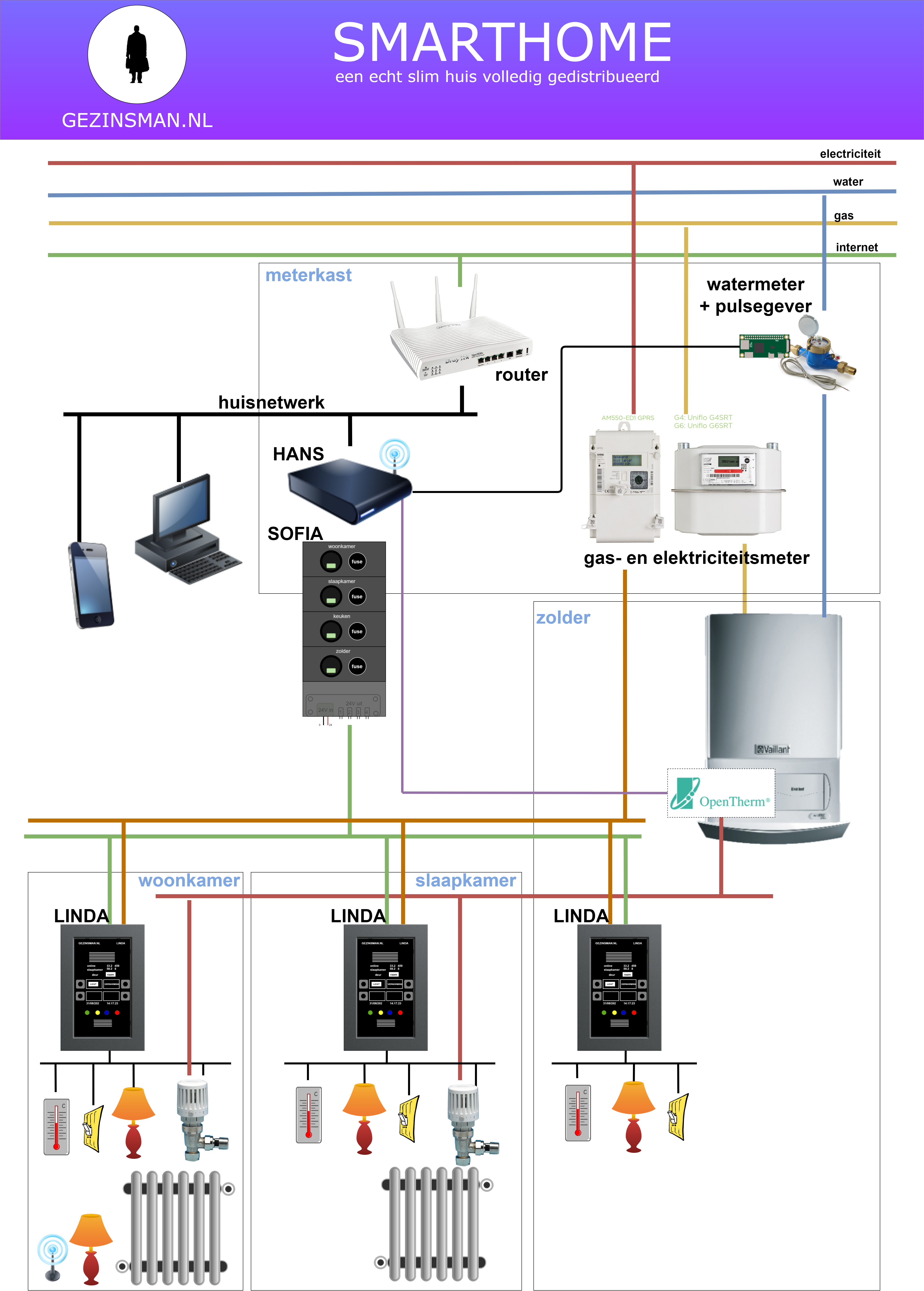
The Energy Service Provider (ESP) has a data connection with the gas- and electricity meter and the Internet Service Provider (ISP) has a connection with the router/modem and provide the house with internet and television. You will find these devices in the meter cupboard.
In the same meter cupboard Hans will be placed. Hans is short for Home Automation Network Server, has two network connections and functions as a bridge between the internet and the smarthome network. Besides that he is also connected to the gas- and electricity meter using the P1-interface. In this way, Hans is able to real-time measure the current electricity- and gas consumption.
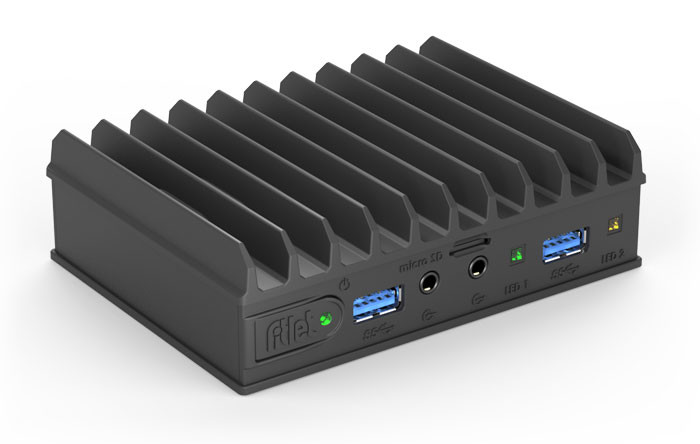
Via the smarthome network, Hans is directly connected with Linda: Minimal one in each room. Linda (Local Interface for Networked Domestic Automation) replaces the classic light switch and makes sure that the room can be operated at any moment (even when Hans is offline!). Linda is direct electrically connected to all kind of sensors and actuators, which combined efforts automate the room locally.
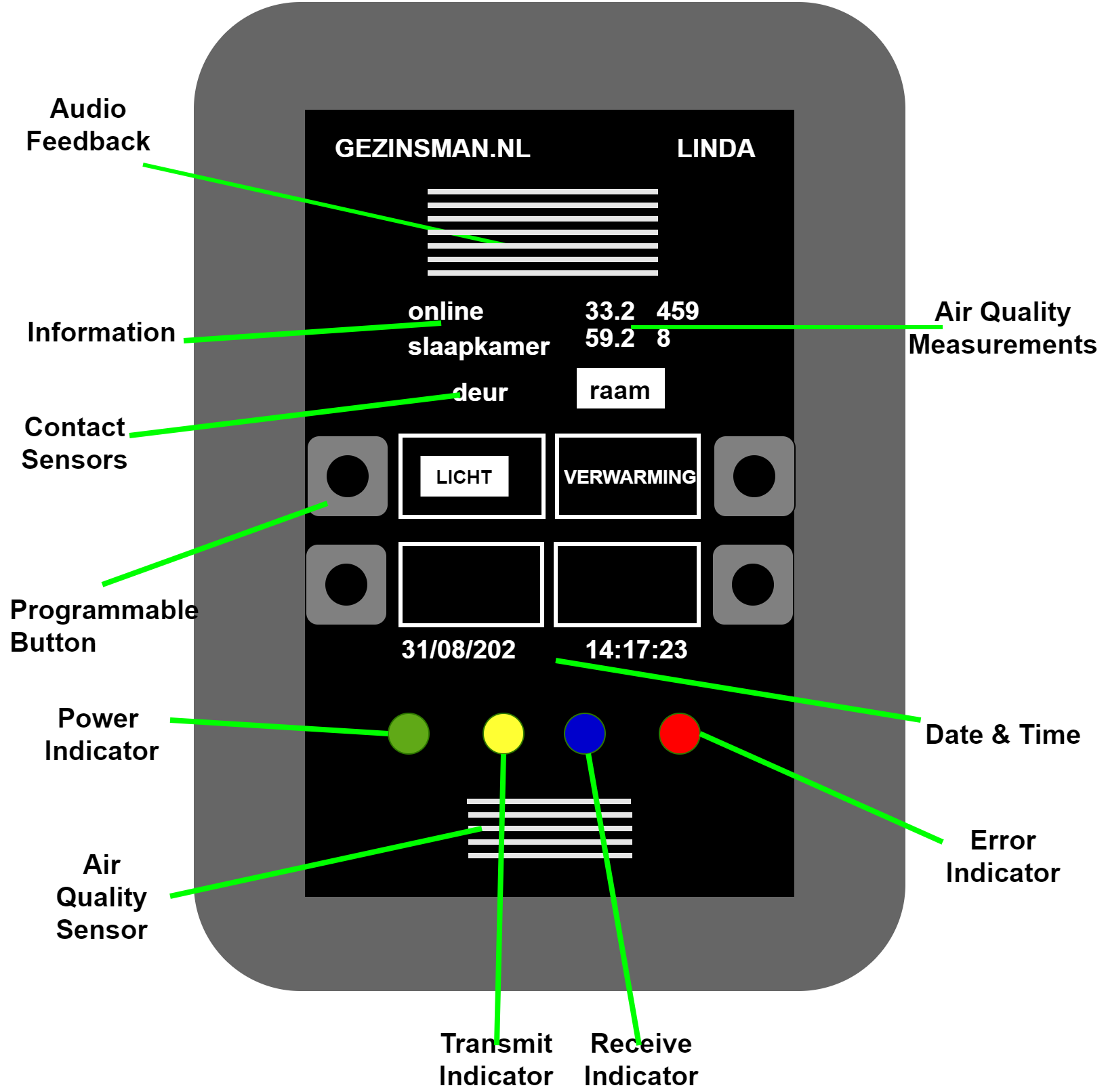
Linda has the following functions and characteristics:
- 4 programmable buttons
- air quality sensor
- voice feedback
- date & time
- status window contactsensor
- status door contactsensor
- power indicator
- network transmit indicator
- network receive indicator
- error indicator
- dual 220V connector
Linda is POE-powered by Sofia, which stands for Stackable Operational Fusebox and Injector Apparatus. This module is placed next to Hans in the meter cupboard.

Sofia is a stackable fuse box and distributes the 24V input volgtage over the rooms and limits, for safety, the power, which is sent to each room. A new module can easily be added, by clicking one on top. The 24V is produced by a commercial-off-the-shelf switching power supply unit with enough power. Each stackable module has a mechanical on/off-switch (with led indicator), a 24V output connector and a standard cartridge fusebox holder.
Smart Thermostat
The system will also be connected to the central heating system, using an OpenTherm thermostat. Since the system is able to measure the temperature in each rooms, and knows if doors and windows are open or closed, the system is able to execute the temperature control optimally and energy efficient. This OpenTherm thermostat will be Commercial-Off-The-Shelf. And via its API interface, the system is able to operate and retrieve input data from the central heating system (an API is a set of public interface requirements, software libraries and source-code, which enables developers to interface with a device).Small and powerful
The smartswitches are small, but don't get me wrong, they are large enough to:- embed a Quad-Core Cortex-A7 processor to execute all kind of intelligent tasks
- have 512 MB memory for volatile and random access memory
- have 32 GB permanent storage capacity
- be connected to the smartbrain using an RJ-45 100Mb ethernet socket for communication
- have 17 general purpose I/O connections to read from sensoric inputs or drive actuator outputs.
The smartswitch can therefor be considered as a node, bridging the nervous system and all kind of electronics, which execute a number of simple tasks, for example:
- switching on/off of lightsources
- detecting if windows or doors are open or closed
- detecting human presence
- unlocking doors
- opening/closing radiators
- measuring the air quality
- measuring the temperature
- switching on/off of waterpumps
- measuring the waterlevel of houseplants
Endless possibilities
The distributed and scalable infrastructure makes it possibe to combine several functions. This will make the house really intelligent and the combination possibilities are practically unlimited and easy to implement.Think about a house, which can be learned independently to:
- switch off the radiator in a room, because of an open window
- trigger an alarm, because of smoke from the barbecue entering the bedroom
- heat up the house, because a resident is on his way home
- switch on the light, because it is dark and someone is entering the room
- switch off the light, because nobody is in the room
- unlock the front door, because a resident wants to enter
- watering the plants, because the soil is too dry
With the basic infrastructure a custom solution can be offered, which fullfills seemlessly the resident requirements. For this system we use the “less is more” principal. The system will be physically as little as possible present (hidden in fuse boxes and in the meter cupboard). Only the most necessary functions will be visible: Each room will be equipped with a small control panel on the place of the standard light switch. With this control panel the residents are able to control the room locally. The deficiency of physical control is amply compensated by virtual control in the shape of a progressive webapp (PWA). This PWA operates in a Chrome/Safari browser on your smartphone, tablet or PC. You don't need to install special software for this, but you are immediately able to control the house.
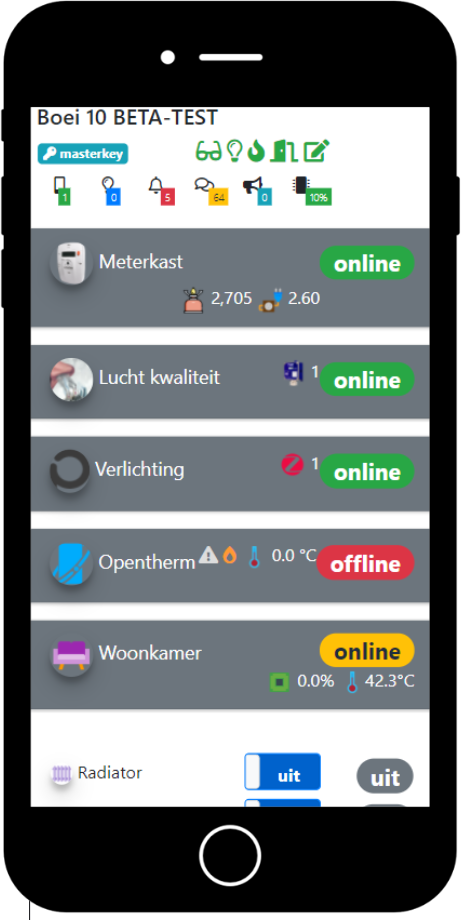
Because by the fact, that the smarthome is seamlessly integrated with the familyman cloud servers (by using the same data distribution techniques, which are also used by NATO countries for sharing intelligence information), it is also possible to inspect and control the house on any place in the world, without opening a port on the router. This is extra safe.
We offer this solution as a service. This means that you don't buy any devices from us, but an off the shelf service, including maintenance.
Smarthome plan
Splendid, this is exactly what I want! I'm building a house soon, what next?The installation company of your house will have an electricity plan. In this plan is documented a.o. where the main power lines are placed and where the wall sockets are placed. We will complement this plan with a smarthome-plan.
Subjects of this smarthome-plan will be a.o.:
- installation of the sensoric inputs and actuator outputs
- installation of the wired network
- installation of the smartswitches
- installation of the backbone
- installation of the smartbrain